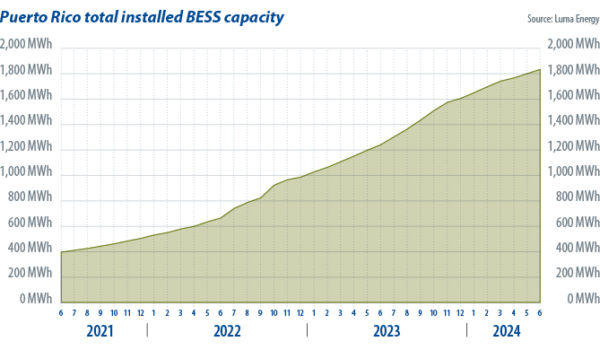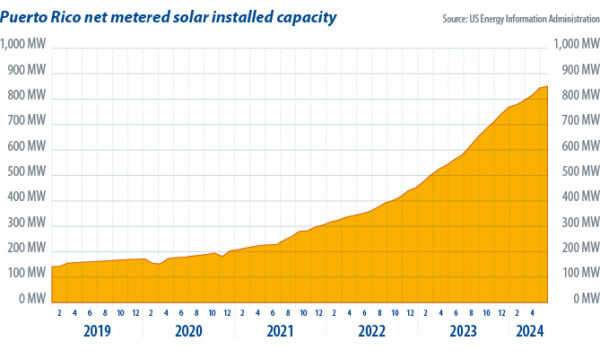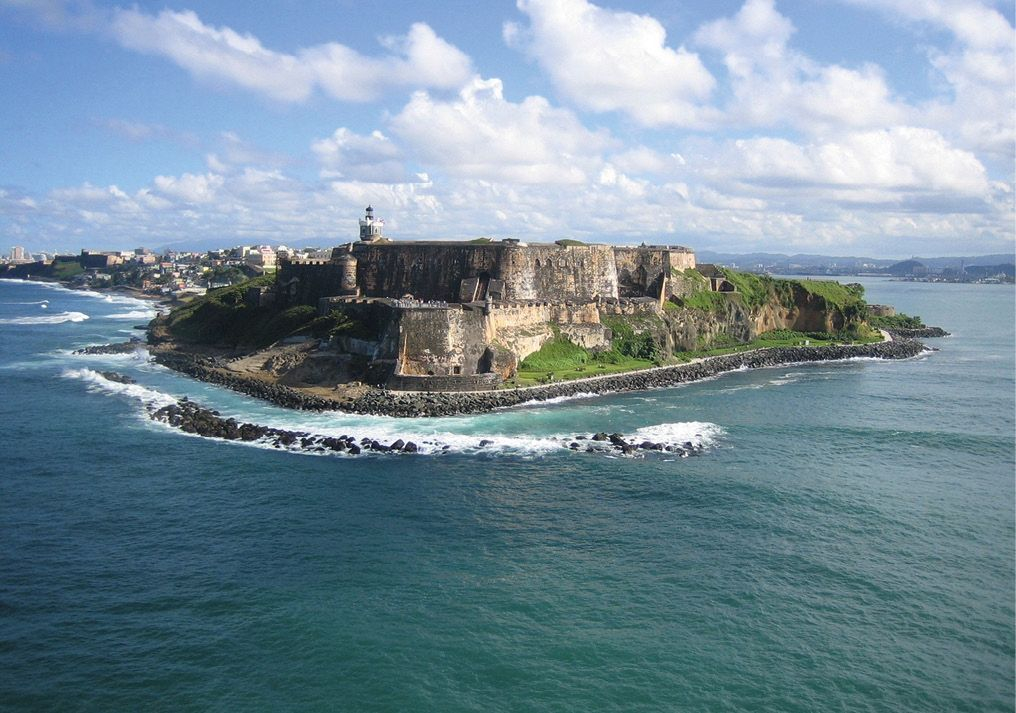Puerto Rico installed more distributed solar per capita than anywhere else in the United States in 2023. Even so, the US territory gets only 12% of its electricity from renewables despite abundant sunshine and high electricity rates that make solar financially attractive.
The Puerto Rican government supports solar. A 2019 law envisages 40% renewables by 2025 and 100% by 2050 and the government has extended net metering for rooftop solar through 2031.
Yet Puerto Rico is a long way from 40% renewables. Of the territory’s three utilities, two have a questionable renewables commitment and one of those is undergoing bankruptcy proceedings. A federal oversight board managing the bankruptcy has filed a lawsuit to invalidate the net metering extension. Questions have been raised over how billions of dollars in post-hurricane emergency funds, to rebuild the grid, are being allocated.

In 2020, the Puerto Rico Energy Bureau mandated utility PREPA to contract 3.75 GW of utility-scale solar and 1.5 GW of four-hour battery storage via six procurement rounds by mid 2023. Three exercises have been staged but US government data indicate Puerto Rico is planning only 126 MW of large-scale solar, on top of the existing 154 MW.
By contrast, the territory has 850 MW (AC) of small-scale, “distributed” PV – one-third of it installed since summer 2023 – and 1.8 GWh of small storage capacity, according to utility Luma Energy (see charts below).
Distributed solar
PJ Wilson, president of the Solar and Energy Storage Association of Puerto Rico (SESA-PR), said the territory could have 18% to 20% clean energy generation before 2026.
Luma Energy has played a “transformational” role in ensuring customers receive net metering credits promptly when they install solar, Wilson said. The utility has also formed a 6,000-customer storage virtual power plant to reduce the number of evening blackouts.
Net metering and fast connection mean distributed solar could comprise more than 90% of the territory’s solar capacity by 2034, according to analyst Wood Mackenzie. Net metering is attractive in a US territory second only to Hawaii for expensive grid electricity. A 2021 study by non-profits Cambio and the Institute for Energy Economics and Financial Analysis (IEEFA) found solar and storage in every home – 2.7 GW of solar and 2.5 GW of storage – plus around 2.7 GW commercial PV, could provide 75% of the territory’s electricity at lower cost than legacy power sources.
Grid reconstruction funds, therefore, should go to solar and storage, argued the nonprofits.
Net metering
The threat to net metering is ominous. In April 2024, the Financial Oversight and Management Board (FOMB) for Puerto Rico, created by a 2016 federal law to restructure the territory’s debt – including PREPA’s borrowings – said it could file a federal lawsuit to block the net metering extension.
The FOMB said its fiscal plan for PREPA requires the Puerto Rico Energy Bureau to determine whether to change net metering. With that yet to occur, the FOMB said the net metering extension was “directly at odds” with the fiscal plan to control costs.
PJ Wilson said net metering has a positive impact on Puerto Rican finances.
The grid value of solar net metered electricity is $0.33/kWh, exceeding the net metering credit of $0.24/kWh, according to a study by energy consultancy Gabel Associates. The grid value consists of $0.27/kWh in avoided energy costs, plus avoided transmission and distribution costs and avoided reliability-related economic losses.
The US National Renewable Energy Laboratory (NREL) calculated that rooftop PV would not drive up electricity costs until after 2030, with Wilson saying net metering could be revisited at that point.
Since May 2024, SESA-PR has successfully lobbied the Biden administration to achieve a Democratic Party majority on the seven-member FOMB board, with the help of the US Solar Energy Industries Association (SEIA). That could not prevent the previous, Republican-majority FOMB filing its net-metering lawsuit in July 2024. Of the lawsuit, Wilson said, in August 2024, “We hope the new Democrat-majority board will vote soon to withdraw.” Otherwise, hopes will hinge on the relevant court rejecting the lawsuit. The FOMB should focus on resolving $3 billion of PREPA debt and dissolve itself, added Wilson.
Eduardo Bhatia, the former president of the Senate of Puerto Rico and now a visiting professor at Princeton, has proposed an alternative approach. He said that the FOMB had included in a letter to the Puerto Rican government a sentence on amending the net metering extension law. Bhatia said “we have to sit down with the oversight board” to “see what could be amended in the law.” He expressed hope that “we can all work together.”

FEMA cash
Another lawsuit, by eight Puerto Rican entities and the US Center for Biological Diversity, challenges the $13 billion allocated to PREPA for post-hurricane grid investment by the US Federal Emergency Management Agency (FEMA). The cash should be spent on “the distributed renewable energy Puerto Ricans need,” the lawsuit states, rather than “the fossil fuel status quo.”
The amount of FEMA cash which has been spent has been “difficult to determine,” according to Center for Biological Diversity Senior Attorney Augusta Wilson, based on public FEMA documentation. In April 2024, the lawyer said, FEMA identified funding authorizations for around $94 million under its 2020 Utilities Repair and Replacement Programmatic Environmental Assessment plan.
The Cambio-IEEFA report in 2021 said PREPA’s ten-year infrastructure plan allocated FEMA funding to bolster its centralized electricity transmission and distribution systems and to add natural gas infrastructure.
The lawsuit brought by the Center for Biological Diversity and others cited a finding of the Cambio-IEEFA study that a 75% distributed-renewable-energy network for Puerto Rico was feasible and would cost less than the existing grid.
In April 2024, the judge handling the lawsuit transferred the case, at the government’s request, to the US District Court for the District of Puerto Rico. The plaintiffs and defendants in the case are scheduled to complete filing their motions for summary judgment by December 2024.
Regarding FEMA’s funding commitments for solar and storage in Puerto Rico to date, a spokesperson said the agency has authorized the purchase of 430 MW of four-hour battery storage systems to be installed at “critical facilities” such as remote water wells, schools, and microgrids for the islands of Vieques and Culebra. FEMA has also committed funding for projects whose initial plans call for 24 MW of solar capacity.
Missed opportunity
SESA-PR’s Wilson has challenged the FOMB’s approach to PREPA’s procurement of 600 MW of utility-scale solar, negotiated between 2018 and 2020, saying that it has had lasting repercussions.
The FOMB was “fully aware” of the negotiations and “never during the multi-year procurement process did FOMB raise any objections,” said Wilson. Yet after PREPA, solar developers, and the energy regulator had formally approved the projects, Wilson said, the FOMB announced that it was canceling 450 MW of the 600 MW of project capacity in mid-2020.
A spokesperson for the FOMB said the contracts “would have resulted in retail energy rates higher than the average retail energy rates projected” in the fiscal plan developed by itself and PREPA, in 2020.
SESA-PR’s Wilson said that the FOMB’s 2020 cancellation of solar projects is “directly relevant” to the FOMB’s July 2024 lawsuit to overturn Puerto Rico’s net-metering law because “never in the multi-year process” from the net-metering law’s introduction, in late 2022, through its enactment in January 2024, “did FOMB raise any objections.”
Had the FOMB not “killed” 450 MW of solar projects, Wilson said, “we probably would have that 450 MW of solar built today and instead of being at 12% renewables we’d be at 17%.”
As a result of the FOMB’s action, Wilson said, “all those developers – some were local, Puerto Rico businesses, some were international developers – all of them deemed Puerto Rico to be a very high-risk market and a lot of them left the market.”
One positive development for utility-scale solar is that in July 2024 the DoE offered a conditional loan guarantee for Puerto Rico projects totaling 200 MW of solar and 285 MW of storage capacity.
Another is that the NREL has estimated that five Puerto Rico reservoirs could host 596 MW of floating solar capacity.
Dirty fuel
Puerto Rico has a third utility, Genera, which is a subsidiary of liquified natural gas company New Fortress Energy. Genera has a contract to operate PREPA’s generating units and “replace the expensive and dirty fuel currently being burned as renewable sources gradually develop by 2050,” according to former Senate President Bhatia in an article published by Puerto Rican newspaper “El Nuevo Dia” in May 2024.
Bhatia voiced concerns about two comments made by Brannen McElmurray, managing director of New Fortress Energy on a call with investors. The former Senate president reported that although McElmurray said adding more reliable generation to accelerate the transition to renewables is a priority for Genera, he also said “we expect” Puerto Rico “to be powered simply by natural gas supplemented with solar and battery.”
Bhatia, who was Senate minority leader when the body passed legislation calling for 40% renewables by 2025 and 100% by 2050, requested “immediate clarification” from New Fortress Energy “regarding its stance on the island’s energy transition.”
New Fortress Energy did not respond to an approach for comment.
This content is protected by copyright and may not be reused. If you want to cooperate with us and would like to reuse some of our content, please contact: editors@pv-magazine.com.








By submitting this form you agree to pv magazine using your data for the purposes of publishing your comment.
Your personal data will only be disclosed or otherwise transmitted to third parties for the purposes of spam filtering or if this is necessary for technical maintenance of the website. Any other transfer to third parties will not take place unless this is justified on the basis of applicable data protection regulations or if pv magazine is legally obliged to do so.
You may revoke this consent at any time with effect for the future, in which case your personal data will be deleted immediately. Otherwise, your data will be deleted if pv magazine has processed your request or the purpose of data storage is fulfilled.
Further information on data privacy can be found in our Data Protection Policy.